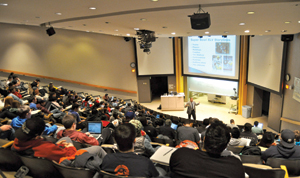As a SportsBusiness Journal reader, you’re likely aware of the expanding number of university sport management programs, the rising flood water of graduates looking for jobs and the vague role of professors as teachers and researchers. Many of you could be unaware that for most tenured (or tenure-track) professors, research is their primary activity and not teaching.
Research, you may say, why would I care about that? We posed that very question.
In December, at the Sport Management Association of Australia and New Zealand’s annual conference in Sydney, one of us was asked to give a three-minute speech on a topic of choice, knowing that one of Australia’s top practitioners would respond to our critique. Since we both were there, we huddled and created a potentially provocative topic: Why isn’t the academic sport management community (and its scholarly research output) more relevant to the sports industry?
To paraphrase a familiar movie line, we wanted to provoke discussion by essentially saying, “Research? We don’t need no stinking research.”
That’s not to say there aren’t exceptions. UEFA, Europe’s most important soccer league, has a robust grant program (entering its fourth edition) that encourages scholars to generate new initiatives in European football research. And the NFL, America’s largest sporting league, has enjoyed a long-standing relationship with Stanford University professor George Foster to facilitate their in-house executive education.
But unlike what we see with the medical profession or via business CEOs, where published research in publications like the New England Journal of Medicine or Harvard Business Review are snapped up by active practitioners, sports industry executives seem comfortable believing only active practitioners can articulate anything worth knowing about the sports business. This seems unfortunate particularly since numerous university researchers are working on cutting-edge developments in sports, many tied to former professionals (who now happen to teach).
It’s important recognizing this academic-practitioner divide in sports management is notable despite massive growth on both fronts over the past decade. This gap, probably driven by trust and performance, is real.
 |
The growth in sport management programs has matched industry growth in the past decade.
Photo by: GABRIELA Z. PEREZ
|
On the academic side, there are more than 1,000 sport management programs worldwide, each with its own set of courses and professors. As the field formalizes, the number of outlets for published research now includes 10 peer-reviewed journals specific to the field and hundreds of others in sports marketing, finance, psychology, economics, law and others that publish regularly. Similarly, the practitioner side has seen considerable growth in the number and complexity of jobs involved.
Sports organizations now seek out trained professionals — former athletes or not — who have specific and specialized skills in areas like sponsorship, finance, human resources, marketing and operations.
So, why the gap relative to research?
There are clearly examples of strong interaction between research and practice. But, the culture of sports and academics in North America is a long way from other disciplines and fields in terms of synergy or integrating with each other.
So, why aren’t more practitioners reading Sport Marketing Quarterly or the Journal of Sport Management? Is it because the academics who write papers for these journals have made their work so hard to understand (or so nuanced in what was researched) that the average practitioner can’t see any value? Is the writing so dense that the key points are obscured?
Or, is the issue a communications one? Is it too expensive or time-consuming to find and read articles in journals like the International Journal of Sport Finance or the European Sport Management Quarterly? Are the articles too slow to hit print?
Or are we — the professors — actually the problem? Are we so focused on case studies, concepts and guest lecturers in our classes that we fail to properly convey the value that exists in our literature to our students in professional programs? In our experiences, we provide our thesis/honors students with a strong grounding and background in the literature, but students like that typically become professors. In our practitioner-focused classes, the peer-review stuff tends to take a back seat.
Perhaps a cultural shift in our field is needed if we’re to narrow this gap and continue to achieve reliable credibility.
Here’s an interesting case to illustrate: One of us is the former North American editor of a peer-reviewed journal designed specifically to link academics and industry around the topic of sponsorship. Then, despite four years of strong scholarship, good reviews, high levels of interest from submitting authors, a strong editorial board of global academics and practitioners, plus popular topics, the journal had to be partnered with another journal as readership and subscriptions were below sustainable levels.
So what to do? We suggested in Sydney that academic organizations look to create clearinghouses of academic experts or, at the very least, design a protocol whereby active research (or recently published work) can be placed in front of leading industry professionals. If the research is valid and shared in a nonthreatening way, we should see some traction.
But the alternative is what bothers us. What if we have an industry that doesn’t care about the research emanating from thousands of academic professionals? What if we have an industry that is so certain about itself that it purposely ignores the research done on its behalf?
It’s a scary thought and one we hope to change.
Rick Burton (rhburton@syr.edu) is the David B. Falk Professor of Sport Management at Syracuse University. Norm O’Reilly (norman.oreilly@ottawa.com.ca) is professor of sport business at the University of Ottawa.





